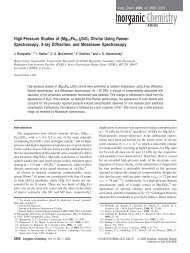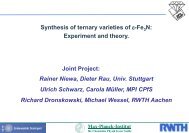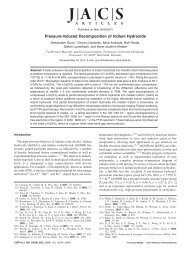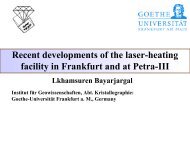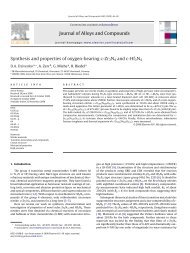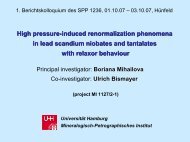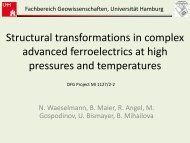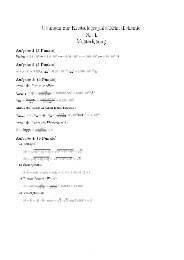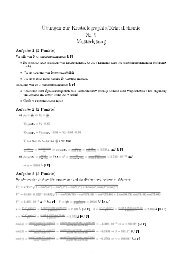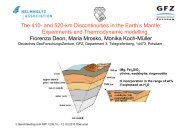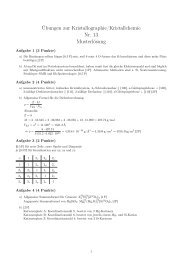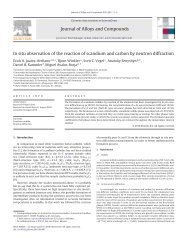Raman spectroscopic study of PbCO3 at high pressures and ...
Raman spectroscopic study of PbCO3 at high pressures and ...
Raman spectroscopic study of PbCO3 at high pressures and ...
You also want an ePaper? Increase the reach of your titles
YUMPU automatically turns print PDFs into web optimized ePapers that Google loves.
sequestr<strong>at</strong>ion <strong>of</strong> anthropogenic CO2 in geologic form<strong>at</strong>ions<br />
(IPCC 2005; Gibbins <strong>and</strong> Chalmers 2008; Bachu 2008).<br />
At ambient conditions all carbon<strong>at</strong>es <strong>of</strong> bivalent c<strong>at</strong>ions<br />
exist in two polymorphic forms with the calcite (CaCO3,<br />
MgCO3, CdCO3, ZnCO3, FeCO3) or aragonite (CaCO3,<br />
BaCO3, SrCO3, <strong>PbCO3</strong>) structure type. Insight into the<br />
<strong>high</strong>-pressure behavior <strong>of</strong> aragonitic CaCO3 can be gained<br />
by investig<strong>at</strong>ing isostructural minerals with larger c<strong>at</strong>ions,<br />
such as BaCO3, <strong>PbCO3</strong>, <strong>and</strong> SrCO3. Whereas these minerals<br />
cannot claim any general geological interest as major<br />
constituents <strong>of</strong> the Earth’s crust or mantle, the P–T conditions<br />
<strong>of</strong> the phase transitions in these compounds are<br />
generally lower than in CaCO3 <strong>and</strong> experimentally easier<br />
accessible (pressure-homologous rule). Pb as a p-group<br />
element has a lone electron pair in its divalent st<strong>at</strong>e which<br />
sets it apart from the closed-shell earth-alkaline c<strong>at</strong>ions.<br />
The lone pair occupies an inert orbital in the lig<strong>and</strong> sphere<br />
<strong>and</strong> can be stereochemically active (Siidra et al. 2008).<br />
Therefore, it is interesting to see whether this special<br />
electronic configur<strong>at</strong>ion results in any kind <strong>of</strong> untypical<br />
<strong>high</strong>-pressure behavior. Various aspects <strong>of</strong> the behavior <strong>of</strong><br />
CaCO3, SrCO3, <strong>PbCO3</strong> <strong>and</strong> BaCO3 under extreme conditions<br />
have already been investig<strong>at</strong>ed.<br />
Lin <strong>and</strong> Liu (1997b) found th<strong>at</strong> both, cerussite (<strong>PbCO3</strong>)<br />
<strong>and</strong> strontianite (SrCO3), undergo a phase transition to a<br />
post-aragonite phase, <strong>at</strong> 17 <strong>and</strong> 35 GPa, respectively. A<br />
<strong>Raman</strong> spectrum <strong>of</strong> a <strong>PbCO3</strong> sample quenched from<br />
22 GPa/1,000 K looked identical to th<strong>at</strong> observed <strong>at</strong><br />
22 GPa <strong>and</strong> room temper<strong>at</strong>ure <strong>and</strong> also <strong>at</strong> above 4 GPa <strong>and</strong><br />
about 1,273 K. This strongly suggests neg<strong>at</strong>ive slope <strong>of</strong> the<br />
phase boundary in a P–T diagram. From single crystal<br />
X-ray diffraction <strong>at</strong> 7.2 GPa it was found (Holl et al. 2000)<br />
th<strong>at</strong> BaCO3 undergoes a first-order transition to a trigonal<br />
structure. A <strong>high</strong>-pressure IR-<strong>spectroscopic</strong> <strong>study</strong> <strong>of</strong><br />
PbCO 3 up to 41 GPa (C<strong>at</strong>alli et al. 2005) showed a phase<br />
transition from an orthorhombic to a trigonal structure. The<br />
spectral changes observed are consistent with the form<strong>at</strong>ion<br />
<strong>of</strong> a small, trigonal unit cell, with space group P31c <strong>and</strong><br />
two formula units per unit cell, corresponding to the <strong>high</strong>pressure<br />
phase <strong>of</strong> BaCO3-III (Holl et al. 2000). Using a<br />
combin<strong>at</strong>ion <strong>of</strong> ab inito techniques <strong>and</strong> <strong>high</strong>-pressure<br />
experiments, Oganov et al. (2006) proposed the structure<br />
<strong>of</strong> the post-aragonite phase <strong>of</strong> CaCO3. Its structure is<br />
similar to those <strong>of</strong> the <strong>high</strong>-pressure phases <strong>of</strong> SrCO 3 (Ono<br />
et al. 2005b) <strong>and</strong> <strong>of</strong> BaCO3-IV (Ono 2007). It is difficult to<br />
compare the results <strong>of</strong> the different authors because the<br />
experiments were carried out under quite different conditions.<br />
Following the pressure-homologous rule, according<br />
to which isostructural compounds containing different<br />
c<strong>at</strong>ions undergo similar phase transitions, but <strong>at</strong> <strong>high</strong>er<br />
<strong>pressures</strong>, when the c<strong>at</strong>ion radii decrease (Brown 1975), it<br />
was suggested th<strong>at</strong> all carbon<strong>at</strong>es with aragonite structure<br />
should have similar phase diagrams, but with different P–T<br />
123<br />
conditions. It is <strong>of</strong> interest to check out whether the pressure<br />
homologous rule is also applicable to the particular<br />
case <strong>of</strong> <strong>PbCO3</strong> with its lone pair effect <strong>and</strong> whether the<br />
construction <strong>of</strong> a general phase diagram for carbon<strong>at</strong>es<br />
with divalent c<strong>at</strong>ions is possible.<br />
Here we report the results <strong>of</strong> our pressure <strong>and</strong> temper<strong>at</strong>ure-dependent<br />
<strong>Raman</strong>-<strong>spectroscopic</strong> experiments on<br />
<strong>PbCO3</strong> which are then used to construct a tent<strong>at</strong>ive P–T<br />
phase diagram <strong>of</strong> cerussite.<br />
Experimental<br />
Extra pure <strong>PbCO3</strong> was used for the experiments (99.999%,<br />
Alfa Aesar GmbH). The <strong>Raman</strong> spectra in the 100-<br />
1,200 cm -1<br />
frequency range were collected using a<br />
LABRAM system spectrometer with a 514.5 nm Ar ? ion<br />
laser as the excit<strong>at</strong>ion light source. The sc<strong>at</strong>tered light was<br />
collected in backsc<strong>at</strong>tering geometry using a liquid nitrogen<br />
cooled CCD detector with a resolution <strong>of</strong> ±2cm -1 .<br />
The <strong>high</strong>-pressure <strong>Raman</strong> spectra were obtained using the<br />
BGI-type diamond anvil cell (DAC), a 259 microscope<br />
objective <strong>and</strong> three accumul<strong>at</strong>ions with 60 s integr<strong>at</strong>ion<br />
time. The investig<strong>at</strong>ed range was extended to 1,600 cm -1<br />
for the characteriz<strong>at</strong>ion <strong>of</strong> the starting m<strong>at</strong>erial.<br />
We used 16-sided type Ia <strong>Raman</strong> ultra low-fluorescence<br />
diamonds with a culet diameter <strong>of</strong> 300 lm. The pressure<br />
was determined by the ruby fluorescence method following<br />
the Piermarini pressure scale (Piermarini et al. 1975). Neon<br />
was used as pressure transmitting medium. A Re gasket<br />
was pre-indented <strong>and</strong> a hole with 150 lm diameter drilled<br />
<strong>at</strong> the center as a sample chamber. Both, <strong>Raman</strong> spectra<br />
<strong>and</strong> the ruby fluorescence, were measured <strong>at</strong> the same spot.<br />
The experiments were carried out under isobaric or<br />
isothermal conditions, respectively. An external resistively<br />
he<strong>at</strong>ed DAC was used for the <strong>high</strong>-temper<strong>at</strong>ure experiments.<br />
The temper<strong>at</strong>ure was controlled by Pt-thermocouples.<br />
The uncertainties <strong>of</strong> the pressure <strong>and</strong> temper<strong>at</strong>ure<br />
measurements are estim<strong>at</strong>ed to be 0.2 GPa <strong>and</strong> 3 K,<br />
respectively, both on compression <strong>and</strong> decompression. The<br />
positions <strong>of</strong> the <strong>Raman</strong> peaks were determined by fitting<br />
Lorentzian functions to the spectra using the OPUS 5.5<br />
(Bruker, 2004) version s<strong>of</strong>tware package.<br />
Results<br />
Phys Chem Minerals<br />
Under ambient conditions, lead carbon<strong>at</strong>e (<strong>PbCO3</strong>) crystallizes<br />
in the aragonite structure with space group Pnma.<br />
The factor group analysis predicts 30 <strong>Raman</strong> active<br />
(9A1g ? 6B1g ? 6B2g ? 9B3g) <strong>and</strong> 18 IR active<br />
(8B1u ? 5B2u ? 5B3u) vibr<strong>at</strong>ional modes. We observed 14<br />
<strong>Raman</strong> modes in the range 100-1,600 cm -1 , in good



